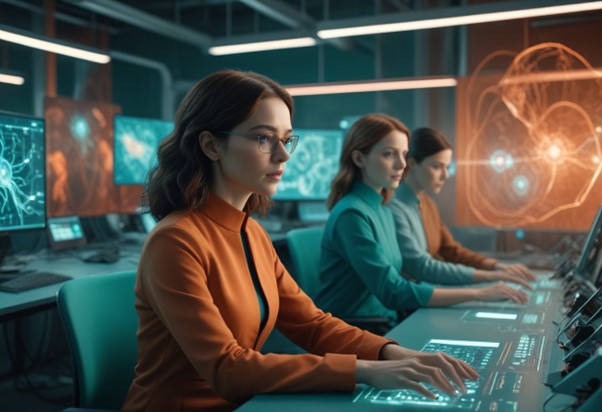3D modeling is an integral aspect of every industry. Before generative AI, it was even difficult for full-time 3D designers to generate 3D models.
However, today, GenAI’s development of 3D models is quite easier and less time-consuming. Today, all leading companies are employing generative AI to develop realistic 3D models for their businesses.
Do you know how generative AI creates 3D models? If not, continue reading! We are going to throw light on generating realistic 3D models with generative AI. Moreover, we will also briefly explain GenAI’s potential benefits and challenges in 3D modeling.
Understanding Generative AI
GenAI is an advanced form of AI. It has the capability to formulate images, text, videos, or other data. This technology uses GenAI models in response to prompts to generate outputs. These Gen AI models analyze the patterns and structure of the input training data to build new and fresh data with the same characteristics.
Key Generative AI Technologies Behind 3D Modeling
Now, let’s discuss the key GenAI technologies in 3D modeling!
Generative Adversarial Networks (GANs)
GANs are a particular class of GenAI algorithms. They include a generator as well as a discriminator that are neural networks. Both neural networks work opposite to each other to create realistic and accurate outputs.
Particularly regarding 3D modeling, you can train these generative adversarial networks on big datasets of 3D models. This is how it will analyze your input and produce new and realistic 3D models with accurate features.
Variational Autoencoders (VAEs)
VAEs are another significant generative AI technology to formulate 3D models. VAEs has the fully capability to learn the intrinsic patterns and structure in the data. This ability enables variational autoencoders to sample from the learnt latent space to develop new 3D models.
Generative AI services help companies control the sampling mechanism. This helps their designers develop 3D models according to their desired features.
Neural Radiance Fields (NeRFs)
Neural Radiance Fields are the third important GenAI technology in 3D modeling. In essence, NeRFs is a new advancement in the GenAI industry. It aims to generate fresh perspectives on complex 3D scenes.
NeRFs can optimize a neural network to exhibit volumetric density and color in a particular scene. Using it, you can make hi-fi renderings even from limited input views. This ‘NeRFs technology’ is extremely beneficial in applications where it is essential to create real-world 3D models.
These examples of its applications are virtual reality (VR) and augmented reality (AR).
Generative AI Applications in 3D Modeling
Now, let’s talk about GenAI applications in 3D modeling!
Game and Entertainment
Gaming and entertainment industry can employ GenAI to create realistic and accurate objects, characters, and environments for their video games and entertainment videos. Generative AI services can help professional designers save their precious time and worthy resources while maintaining the quality of the visuals and content.
Architecture and Urban Planning
Generative AI technology can also help architects and urban planners in creating their building designs and city layouts. This technology will exactly help them optimize their criteria like aesthetics, functionality, etc. Using generative AI, they can lead to sustainable and modern urban environments.
Healthcare and Medical Imaging
Generative AI has also made huge strides in the healthcare industry, especially in medical imaging and surgery planning. It today allows healthcare professionals to create AI 3D models of organs and tissues.
It helps them provide patients with more personalized treatment plans. Moreover, surgeons can practice healthcare processes on realistic virtual models. This will not only enhance precision but also improve patient outcomes.
E-commerce and Virtual Try-Ons
When it comes to the e-commerce industry, generative AI is also making a huge impact on virtual try-ons. This has started helping ecommerce businesses in providing more personalized shopping experiences.
Today, retail businesses create realistic 3D models of their products to let their customers view the items before buying them. This has been decreasing the products’ return rates and boosting the retention rates.
Generative AI Benefits in 3D Modeling
Collaborating with a generative ai development company means that you will save your hard-earned money to create realistic 3D models. Not only is it budget-friendly, it will also make designs more quickly.
Moreover, generative AI will enable you to get more innovative design options as it is a hug of enhanced creativity. GenAI will help your designers push the limits of their innovative mindsets. The feature that has increased the demand for GenAI in 3D modeling is its ability to optimize 3D models according to your customized criteria of features and functionalities.
Generative AI Challenges in 3D Modeling
There are many generative AI benefits in 3D modeling, but it also has some challenges as well. For example, quality control is one of the prevailing challenges. Many professionals claim that it is still difficult to ensure quality and accuracy in AI-generated 3D models.
Moreover, there are some ethical challenges as well when it comes to generative AI in 3D modeling. It raises ethical concerns regarding intellectual property and misuse of AI-generated content.
Final Remarks
Generative AI has been providing amazing opportunities to businesses to incorporate creativity and efficiency in their 3D models. Using technologies such as GANs, VAEs, and NeRFs, you can generate real-world 3D models. You must utilize generative AI up to the full potential to build incredible future of your business.
